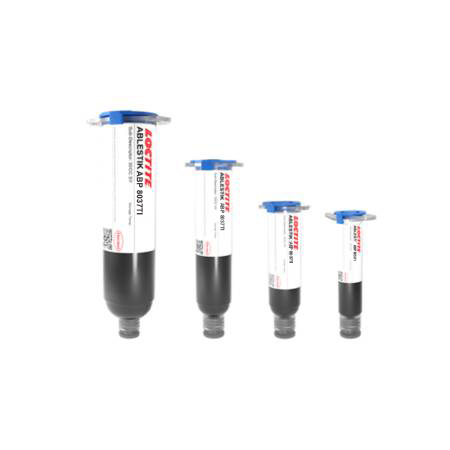LOCTITE ABLESTIK ABP 8037TI
Harmonization Code : 3506.91.90.99 | Prepared glues and other prepared adhesives, not elsewhere specified or included; products suitable for use as glues or adhesives, put up for retail sale as glues or adhesives, not exceeding a net weight of 1 kg ; Adhesives based on polymers of headings 3901 to 3913 or on rubber; Other ; Other
Main features
- High-reliability LED manufacture
- High thermal conductivity
- Small die on Au-finish LF
Product Description
LOCTITE ABLESTIK ABP 8037TI silver-filled conductive adhesive is recommended for use in the attachment of integrated circuits and components onto metal leadframes and advanced substrates.
LOCTITE ABLESTIK ABP 8037TI silver-filled die attach adhesive paste is specifically designed to attach small diodes in high volume manufacturing. Even more specifically, it is the highest volume silver-filled die attach paste for high reliability LED attach and manufacture when using small die on Au-finished leadframes. Used in high-volume manufacturing throughout China and Malaysia.
LOCTITE ABLESTIK ABP 8037TI is similar to Loctite Ablestik ABP 8037T, with a minor raw material change that made it adjust its naming convention.
Cure Schedule
- 30 minute ramp to 175ºC, hold 30 minutes @ 175 °C
- 30 minute ramp to 150ºC, hold 30 minutes @ 150 °C
Technical Specifications
| General Properties | |||||||||||||||
| |||||||||||||||
| |||||||||||||||
| Work life @25°C Work life @25°C Work life is the amount of time we have to work with a material until it is no longer able to be easily worked and applied on a substrate. It is based on the change in viscosity and it can rely on the application requirements. | 24 hours | ||||||||||||||
| Physical Properties | |||||||||||||||
| Thixotropic index Thixotropic index Thixotropic Index is a ratio of a material s viscosity at two different speeds in Ambient temperature, generally different by a factor of ten. A thixotropic material s viscosity will decrease as agitation or pressure is increased. It indicates the capability of a material to hold its shape. Mayonnaise is a great example of this. It holds its shape very well, but when a shear stress is applied, the material easily spreads. It helps in choosing a material in accordance to the application, dispense method and viscosity of a material. | 5.8 | ||||||||||||||
| Viscosity Viscosity Viscosity is a measurement of a fluid’s resistance to flow. Viscosity is commonly measured in centiPoise (cP). One cP is defined as the viscosity of water and all other viscosities are derived from this base. MPa is another common unit with a 1:1 conversion to cP. A product like honey would have a much higher viscosity -around 10,000 cPs- compared to water. As a result, honey would flow much slower out of a tipped glass than water would. The viscosity of a material can be decreased with an increase in temperature in order to better suit an application | 11,000 mPa.s | ||||||||||||||
| Chemical Properties | |||||||||||||||
| |||||||||||||||
| Mechanical Properties | |||||||||||||||
| |||||||||||||||
| Thermal Properties | |||||||||||||||
| |||||||||||||||
| Glass Transition Temperature (Tg) Glass Transition Temperature (Tg) The glass transition temperature for organic adhesives is a temperature region where the polymers change from glassy and brittle to soft and rubbery. Increasing the temperature further continues the softening process as the viscosity drops too. Temperatures between the glass transition temperature and below the decomposition point of the adhesive are the best region for bonding. The glass-transition temperature Tg of a material characterizes the range of temperatures over which this glass transition occurs. | 46 °C | ||||||||||||||
| Thermal Conductivity Thermal Conductivity Thermal conductivity describes the ability of a material to conduct heat. It is required by power packages in order to dissipate heat and maintain stable electrical performance. Thermal conductivity units are [W/(m K)] in the SI system and [Btu/(hr ft °F)] in the Imperial system. | 4.1 W/m.K | ||||||||||||||



